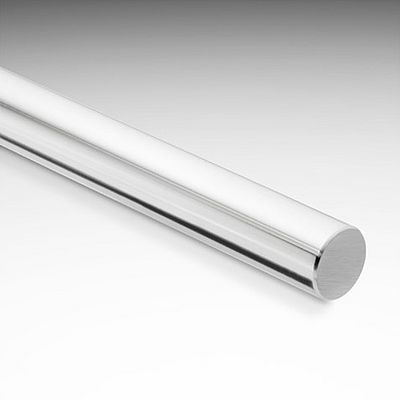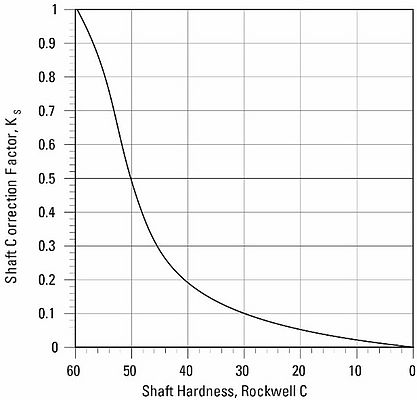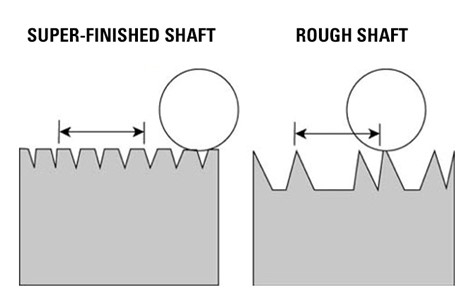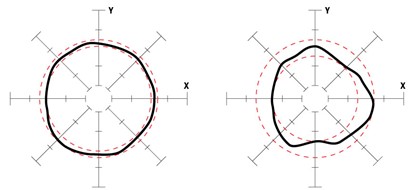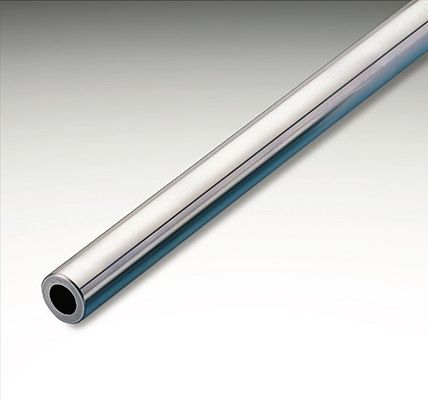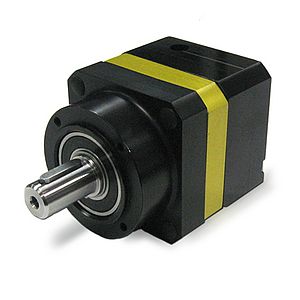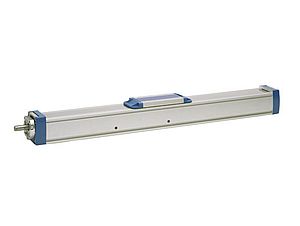Thomson. While some may use a less expensive shaft with inferior characteristics, the modest savings in original shafting cost usually result in a decreased life. A basic understanding of crucial round shaft factors and how they influence precision and durability will be invaluable in helping you select the ideal shaft for your designs.
Understanding shaft physical form factors
Key shaft features that interact to impact precision and durability include hardness, straightness, surface finish, roundness and cylindricity.
Hardness
Shaft hardness affects the dynamic load rating of the bearing. Harder shaft surfaces better resist permanent deformation under single-point loading of bearing balls, thus maximising the life of the Linear Ball Bushing® Bearing and the rail itself.
Figure 1 shows how the bearing load correction factor and life expectancy must be adjusted downward as hardness drops below 60 HRC.
The depth of the case hardness is another factor in determining overall life. Higher loads subject the shaft to deeper bearing ball penetration and higher stress concentration. High deformation resistance requires deep and uniform case hardness and must be engineered to Linear Ball Bushing Bearing size and load expectations. Best-in-class Thomson 60 Case® carbon steel shafts, for example, might have case hardness values ranging from 63-67 HRC and case depth of values of up to 2.54 mm depending on shaft size. Particular deep case (DC) options are available with case depths up to 6.35 mm helping to achieve longer life.
Straightness
The straighter the shaft, the higher the precision. Lack of straightness can cause binding, noise generation, premature wear and ball bearing failure. Best-in-class linear shafts are straight to within 0.0254 mm per 300 mm cumulative (0.0508 mm TIR). They can accommodate special straightness requirements of 0.0127 mm per 300 mm cumulative (0.0254 mm TIR) for critical, high-accuracy applications.
Surface finish
Surface finish (or RA for roughness average) is a measure of shaft smoothness. It represents the average height of the microscopic peaks and valleys along the length of the surface of the shaft. Superfinishing levels peak, producing plateaus. (Figure 3.) This increases the available surface area and distributes the load more uniformly. Surface finishing impacts Linear Ball Bushing Bearing travel smoothness and life, load levels and friction.
Roundness
The rounder the shaft, the more uniform the distribution of bearing loads and the longer the bearing travel life. Variations in shaft radii can cause rapid alternate loading. Shafts that are out of round by even 0.00254 mm can preload ball tracks, causing uneven wear, premature failure and can shorten bearing life by as much as 50%.
High precision applications require a roundness tolerance of 0.002032 mm, which manufacturers achieve by a process known as centerless grinding, as shown in Figure 4.
Cylindricity
Cylindricity is a measure of the degree of conformance of the shaft (or linear race of the Linear Ball Bushing Bearing) outside surface to a true cylinder. High cylindricity ensures consistency of roundness and straightness along the entire length of the shaft – not just in a particular location. This ensures uniform load distribution, maximizing load capacity and travel life. High cylindricity equals higher precision, higher load capacity and longer life.
Taper is a cylindricity measure of the change in diameter any place along the length of the shaft. It subjects the bearing to shock and preload conditions and can cause one bearing to be loaded higher than another. Going in and out of a preloaded condition causes premature wear, which drastically reduces overall bearing life expectancy. For linear motion applications, look for shafts with a maximum taper of half the diameter tolerance over the length of the shaft. This ensures uniform distribution of bearing loads and maximises bearing travel life.
Material matters
The most common materials used in shafts are carbon steel, 52100 tubular carbon steel, 440C stainless steel, 300 series stainless steel, and aluminum. Each has unique capabilities.
Carbon steel – Least expensive and most common, Offers the hardest and deepest case, with high tensile strength, but requires lubrication and not recommended for corrosive environments.
440C stainless steel – DIN EN X110Cr17 – Decent corrosion resistance and can be hardened for use with Linear Ball Bushing Bearings.
300 series stainless steel – DIN EN X8CrNiS18-9 -- A non-magnetic option, for use with bearings can’t be hardened. High sulfur content, gives high machineability but at the cost of corrosion resistance and toughness. Various grades offer trade-offs between corrosion resistance and machineability.
52100 tubular carbon steel – DIN EN 100Cr6
52100 tubular carbon steel provides a lighter shaft and a channel for routing fluids, lines or other components. (Figure 6) It is bearing-grade chromium steel with a carbon content that allows for good hardenability, with values in the range of 58 to 62 HRC.
Aluminum
Aluminum shafting usually comes with either a ceramic or hard-anodized coating. The coating hardness is nominal at surface level only. The shaft underneath the coating is soft and would deform at high point loading of a Linear Ball Bushing Bearing so it is not suitable for use with them. Weight reduction is significant compared to other shafting materials and corrosion resistance is good.
Plating extends life
The two most common plating options to reduce wear and increase corrosion resistance are hard chrome and Armoloy. Both are offered with a thickness near 0.00254 mm, increased hardness levels and long life but Armoloy has a higher hardness level of 78 HRC compared to a range of 65 to 72 HRC for hard chrome. Armoloy also adheres better to the base metal, which helps prevent chipping, cracking, flaking or peeling.
Help is available
Having an informed understanding of the factors that impact precision and durability will help designers make the optimal shafting choices for their applications. Understanding the characteristics of the production processes and material qualities, will have the greatest impact oj the choice of materials, but depending on applications mounting, support and configuration may also play significantly. Increasingly, motion control vendors are providing sizing and selection tools that enable designers to easily enter specifications and receive recommendations immediately.
Eduard Schweinfort, Product Line Manager EMEA & ASIA – Screws, LB&G and Screw Jacks, Thomson Neff Industries GmbH.


